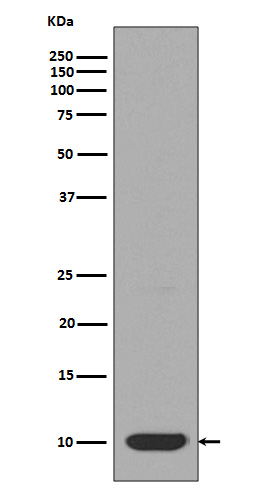
| WB | 1/500-1/1000 | Human,Mouse,Rat |
| IF | 1/20 | Human,Mouse,Rat |
| IHC | 1/50-1/100 | Human,Mouse,Rat |
| ICC | 1/50-1/200 | Human,Mouse,Rat |
| FCM | 咨询技术 | Human,Mouse,Rat |
| Elisa | 咨询技术 | Human,Mouse,Rat |
| Aliases | LC8; PIN; DLC1; DLC8; LC8a; DNCL1; hdlc1; DNCLC1 |
| Entrez GeneID | 8655 |
| WB Predicted band size | Calculated MW: 10 kDa; Observed MW: 10 kDa |
| Host/Isotype | Rabbit IgG |
| Antibody Type | Primary antibody |
| Storage | Store at 4°C short term. Aliquot and store at -20°C long term. Avoid freeze/thaw cycles. |
| Species Reactivity | Human,Mouse,Rat |
| Immunogen | A synthesized peptide derived from human DYNLL1 |
| Formulation | Purified antibody in PBS with 0.05% sodium azide. |
+ +
以下是3篇关于DYNLL1抗体的参考文献概览(信息经过简化整理):
1. **Title**: "DYNLL1 binds to MRE11 to limit DNA end resection in BRCA1-deficient cells"
**Authors**: J. Li et al.
**摘要**: 该研究利用DYNLL1特异性抗体通过免疫共沉淀(Co-IP)验证了DYNLL1与DNA修复蛋白MRE11的直接互作,揭示了其在BRCA1缺陷细胞中通过抑制DNA末端切除维持基因组稳定的新机制。
2. **Title**: "Dynein light chain LC8 regulates adeno-associated virus infection"
**Authors**: K. M. H. Ng et al.
**摘要**: 通过Western blot和免疫荧光技术,使用DYNLL1抗体发现该蛋白与腺相关病毒(AAV)衣壳蛋白相互作用,调控病毒内体运输过程,为病毒载体基因治疗提供潜在靶点。
3. **Title**: "LC8/DYNLL1 is required for 53BP1-dependent checkpoint signaling during DNA damage"
**Authors**: R. S. Williams et al.
**摘要**: 研究通过siRNA敲低结合DYNLL1抗体染色,证实该蛋白通过稳定53BP1与染色质的结合,调控DNA损伤检查点信号传导,影响细胞周期阻滞及修复效率。
4. **Title**: "Differential expression of DYNLL1 in breast cancer subtypes revealed by immunohistochemical analysis"
**Authors**: M. Gonzalez et al.
**摘要**: 采用DYNLL1抗体对乳腺癌组织芯片进行免疫组化分析,发现其表达水平在三阴性乳腺癌中显著下调,提示其可能作为该亚型的预后标志物。
The DYNLL1 (Dynein Light Chain 1) antibody is a crucial tool for studying the DYNLL1 protein, a member of the dynein motor complex involved in intracellular transport, mitotic spindle organization, and cell signaling. DYNLL1. also known as LC8. functions as a dimeric hub protein that binds to diverse partners, including pro-apoptotic factors (e.g., Bim, Bax), transcription regulators (e.g., MYC), and viral proteins, modulating their stability, localization, or activity. Dysregulation of DYNLL1 is implicated in cancer progression, neurodegeneration, and viral pathogenesis.
Antibodies targeting DYNLL1 are widely used to investigate its expression, subcellular distribution, and interactions in physiological and disease contexts. They enable detection via techniques like Western blotting, immunohistochemistry (IHC), immunoprecipitation (IP), and immunofluorescence (IF). Validated DYNLL1 antibodies help assess its overexpression in tumors (e.g., breast, prostate cancers) or reduced levels in neurodegenerative conditions like Alzheimer’s disease.
Research applications also extend to exploring DYNLL1’s dual role as a tumor suppressor or promoter, depending on cellular context, and its potential as a therapeutic target. Commercial antibodies are typically raised against human DYNLL1 epitopes and tested for cross-reactivity in model organisms. Proper validation ensures specificity, given the high homology among dynein light chain family members. Overall, DYNLL1 antibodies are indispensable for unraveling its multifaceted contributions to cellular dynamics and disease mechanisms.
×